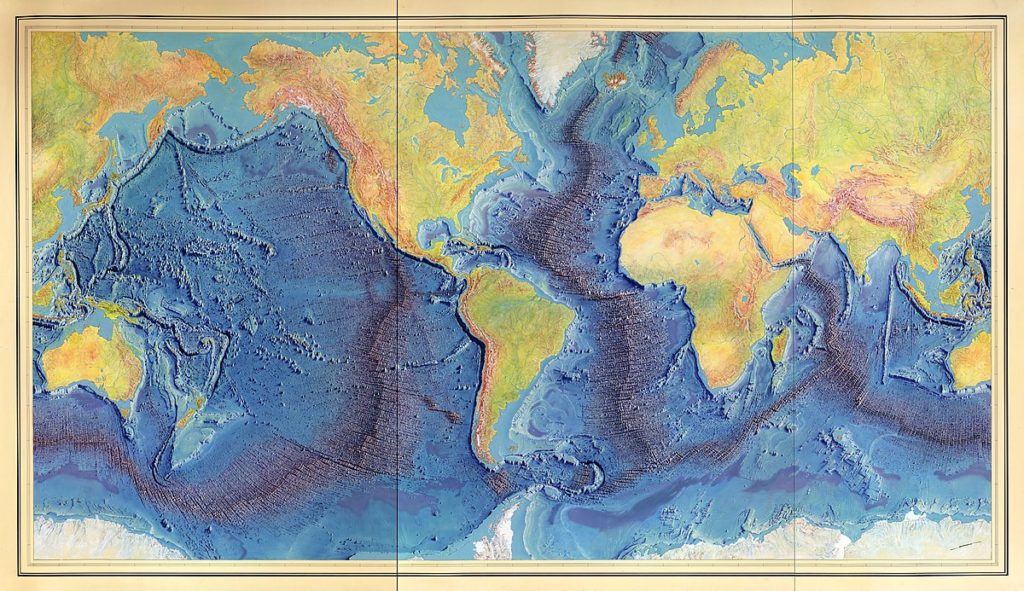Sluggish spreading rates could mean a drop in greenhouse gas emissions from volcanoes
14 April 2022

Painting of the Mid-Ocean Ridge with rift axis by Heinrich Berann based on the scientific profiles of Marie Tharp and Bruce Heezen (1977).
AGU press contact:
Rebecca Dzombak, +1 (202 777-7492), [email protected] (UTC-4 hours)
Contact information for the researchers:
Colleen Dalton, Brown University, [email protected] (UTC-4 hours)
WASHINGTON—A new global analysis of the last 19 million years of seafloor spreading rates found they have been slowing down. Geologists want to know why the seafloor is getting sluggish.
New oceanic crust forms continuously along rifts thousands of miles long on the seafloor, driven by plate tectonics. As subduction pulls old crust down, rifts open up like fissures in an effusive volcano, drawing hot crust toward the surface. Once at the surface, the crust begins to cool and gets pushed away from the rift, replaced by hotter, younger crust.
This cycle is called seafloor spreading, and its rate shapes many global processes, including sea level and the carbon cycle. Faster rates tend to cause more volcanic activity, which releases greenhouse gases, so deciphering spreading rates helps contextualize long-term changes in the atmosphere.
Today, spreading rates top out around 140 millimeters per year, but peaked around 200 millimeters per year just 15 million years ago in some places, according to the new study. The study was published in the AGU journal Geophysical Research Letters, which publishes high-impact, short-format reports with immediate implications spanning all Earth and space sciences.
The slowdown is a global average, the result of varying spreading rates from ridge to ridge. The study examined 18 ridges, but took a particularly close look at the eastern Pacific, home to some of the globe’s fastest spreading ridges. Because these slowed greatly, some by nearly 100 millimeters per year slower compared to 19 million years ago, they dragged down the world’s average spreading rates.
It’s a complex problem to solve, made more difficult by the seafloor’s slow and steady self-destruction.
“We know more about the surfaces of some other planets than we do our own seafloor,” said Colleen Dalton, a geophysicist at Brown University who led the new study. “One of the challenges is the lack of perfect preservation. The seafloor is destroyed, so we’re left with an incomplete record.”
The seafloor is destroyed in subduction zones, where oceanic crust slides under continents and sinks back into the mantle, and is reforged at seafloor spreading ridges. This cycle of creation and destruction takes about every 180 million years, the age of the oldest seafloor. The crust’s magnetic record tracks this pattern, producing identifiable strips every time the Earth’s magnetic field reverses.
Dalton and her co-authors studied magnetic records for 18 of the world’s largest spreading ridges, using seafloor ages and their areas to calculate how much ocean crust each ridge has produced over the last 19 million years. Each ridge evolved a little differently: some lengthened, some shrank; some sped up, but almost all slowed down. The overall result of Dalton’s work is that average seafloor spreading slowed down by as much as 40% over that time.
The driver here might be located at subduction zones rather than spreading ridges: for example, as the Andes grow along the western edge of the South American continent, the mountains push down on the crust.
“Think of it as increased friction between the two colliding tectonic plates,” Dalton said. “A slowdown in convergence there could ultimately cause a slowdown in spreading at nearby ridges.” A similar process could have operated underneath the Himalaya, with the rapidly growing range slowing spreading along the ridges in the Indian Ocean.
However, Dalton points out, this added friction can’t be the only driver of the slowdown, because she found slowing rates globally and mountain growth is regional. Larger-scale processes, like changes in mantle convection, could also be playing a role. In all likelihood, she concludes, it’s a combination of both. To learn more, Dalton hopes to collect absolute plate speeds, rather than the relative speeds used in this study, which will better allow her to determine the cause of the slowdown.
###
AGU (www.agu.org) supports 130,000 enthusiasts to experts worldwide in Earth and space sciences. Through broad and inclusive partnerships, we advance discovery and solution science that accelerate knowledge and create solutions that are ethical, unbiased and respectful of communities and their values. Our programs include serving as a scholarly publisher, convening virtual and in-person events and providing career support. We live our values in everything we do, such as our net zero energy renovated building in Washington, D.C. and our Ethics and Equity Center, which fosters a diverse and inclusive geoscience community to ensure responsible conduct.
Notes for Journalists:
This research study is published with open access and is freely available. Download a PDF copy of the paper here. Neither the paper nor this press release is under embargo.
Paper title:
“Evidence for a Global Slowdown in Seafloor Spreading Since 15 Ma”
Author information:
- Colleen Dalton (corresponding author), Timothy Herbert, Department of Earth, Environmental, and Planetary Sciences, Brown University, Providence, RI, USA
- Douglas S. Wilson, Marine Science Institute, University of California-Santa Barbara, CA, USA